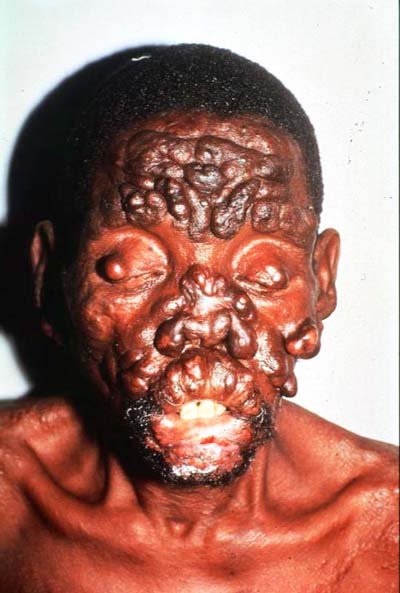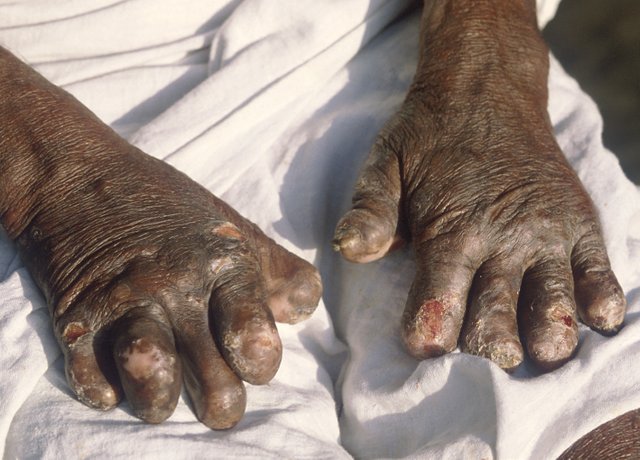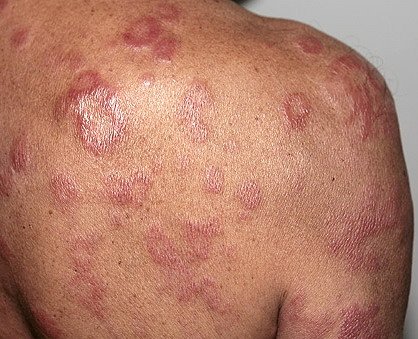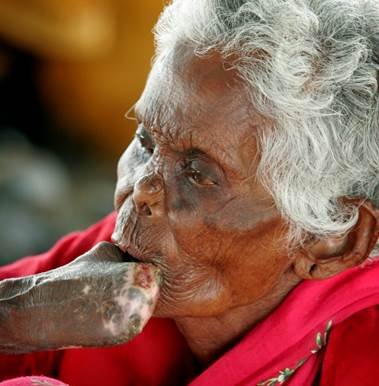LEPROSY - MYCOBACTERIUM LEPRAE
Leprosy is a persistent long-term serious disease which is the effect of a bacillus, Mycobacterium leprae.
M. leprae multiplies gradually and slowly but surely and the incubation period of the disease typically is 5 years. In some instances, symptoms might occur within 12 months but can also take so long as 20 years.
The condition mainly impacts the skin, the peripheral nerves, mucosa of the top respiratory tract, as well as the eyes.
Leprosy is curable with multidrug remedy (MDT).

source:https://web.stanford.edu/class/humbio103/ParaSites2005/Leprosy/pictures/face%20nodules
However is not highly infectious, leprosy is transmitted via droplets, from the nasal area (nostrils) and the oral cavity, during close and recurrent contacts with unattended cases.
Untreated, leprosy can cause intensifying and long-lasting damage to the skin, nerves, limbs, and eyes.
Official statistics from 138 countries from 6 WHO area show the global recorded prevalence of leprosy to be at 176 176 instances by the end of 2015. Through the same calendar year 211 973 new conditions were reported.
Introduction
Leprosy is a chronic infectious disease induced by Mycobacterium leprae, an acid-fast, rod-shaped bacillus. The condition mainly impacts the skin, the peripheral nerves, mucosa of the top respiratory system, and the eyes.
Leprosy is curable and treatment in the first phases can prevent impairment.
Multidrug remedy (MDT) treatment has been offered through WHO cost-free to all or any patients worldwide since 1995. MDT offers a highly effective treatment for all sorts of leprosy.
Eradication of leprosy as open public medical condition (thought as an authorized prevalence of significantly less than 1 circumstance per 10 000 individuals was achieved internationally in the entire year 2000. A lot more than 16 million leprosy patients have been cured with MDT within the last 20 years.

source: http://www.forgottendiseases.org/assets/Leprosy/img/Leprosy_deformities_hands_WmCommons
Leprosy is a chronic disease induced by the acid-fast, rod-shaped bacillus Mycobacterium leprae. Leprosy can be viewed as 2 linked diseases that generally affect superficial cells, especially the skin and peripheral nerves. Primarily, a mycobacterial disease causes several cellular immune reactions. These immunologic occurrences then elicit the next area of the disease, a peripheral neuropathy with possibly long-term consequences.
The interpersonal and psychological ramifications of leprosy, as well as its highly obvious debilities and sequelae have led to a historical stigma associated with leprosy. To reduce the prejudice against people that have leprosy, the problem is also called Hansen disease, called after G.A. Hansen, who's acknowledged with the 1873 breakthrough of M.leprae. This mycobacterium increases extremely slowly but surely and is not effectively cultured in vitro.
Causes
Leprosy is |induced by the bacteria Mycobacterium leprae. It isn't very contagious and has an extended incubation period (time before symptoms show up), rendering it hard to learn where or when someone contacted/found the condition. Children are much more likely than men and women to get the condition.
Experts assume that the bacteria propagate whenever a person breathes in little airborne droplets released when someone with leprosy coughs or sneezes. The bacteria can also be offered by getting into connection with the nasal essential fluids of the person with leprosy. Leprosy has 2 common varieties: tuberculoid and lepromatous. Both varieties produce sores on the skin. However, the lepromatous form is more serious. It triggers large lumps and bumps (nodules).
Leprosy is common in many countries worldwide, and in temperate, {exotic}, and subtropical climates. About 100 conditions per calendar year are diagnosed in america.
A lot of people who are exposed to the bacteria don't develop the condition. It is because their disease fighting capability can combat off the bacteria.
Pathophysiology
Leprosy can express in various varieties, depending on host reaction to the organism.
Individuals who've a vigorous mobile immune respond to M.leprae possess the tuberculoid form of {the condition that usually entails your skin and peripheral nerves. The amount of skin lesions is bound, and they have a tendency to be dry out and hypoesthetic. Nerve engagement is usually asymmetric. This form of the condition is generally known as paucibacillary leprosy due to low quantity of bacteria in your skin lesions (ie, < 5 skin damage, with lack of microorganisms on smear). Results of epidermis assessments with antigen from wiped out microorganisms are positive in them.
Individuals with nominal cellular immune system response possess the lepromatous form of the condition, which is seen as a considerable skin participation. Skin lesions in many cases are referred to as infiltrated nodules and plaques, and nerve participation is commonly symmetric in syndication. The organism grows best at 27-30?C; therefore, skin damage have a tendency to develop in the cooler parts of the body, with sparing of the groin, axilla, and head. This form of the condition is generally known as multibacillary leprosy due to large numbers of bacteria within the lesions (ie, >6 lesions, with possible visualization of bacilli on smear). Results of epidermis assessments with antigen from wiped out microorganisms are nonreactive.

source:http://thefitnesstips.com/wp-content/uploads/2012/02/Leprosy
Patients could also present with top features of both categories; however, as time passes, they usually develop to 1 or the other indeterminate or borderline leprosy. Oddly enough, most those who face leprosy never develop the condition.
Signs and Symptoms
Discolored patches of skin, usually flat, that may be numb and look faded (lighter than the skin around)
Growths (nodules) on the skin
Thick, stiff or dry skin
Painless ulcers on the soles of feet
Painless swelling or lumps on the face or earlobes
Loss of eyebrows or eyelashes
Symptoms caused by damage to the nerves are:

source:http://risingstaroutreach.org
Numbness of affected areas of the skin
Muscle weakness or paralysis (especially in the hands and feet)
Enlarged nerves (especially those around the elbow and knee and in the sides of the neck)
Eye problems that may lead to blindness (when facial nerves are affected)
Mortality/Morbidity
Leprosy is hardly ever fatal, and the principal consequence of disease is nerve impairment and debilitating sequelae. Relating to one research, 33-56% of recently diagnosed patients already viewed signs or symptoms of impaired nerve function. Corresponding to estimations, 3 million individuals who have completed multidrug remedy for leprosy have suffered disability anticipated to nerve destruction. Although both lepromatous leprosy and tuberculoid leprosy involve the skin and peripheral nerves, tuberculoid leprosy has more serious manifestations. Nerve engagement results in lack of sensory and electric motor function, which might lead to consistent injury and amputation. The ulnar nerve is mostly involved.
Damage in the next nerves is associated with quality impairments in leprosy:
Ulnar and median - Clawed hand
Posterior tibial - Plantar insensitivity and clawed toes
Common peroneal - Feet drop
Radial cutaneous, cosmetic, and increased auricular nerves
Treatment
Several antibiotics are used to kill the bacteria that cause the disease. These include dapsone, rifampin, clofazamine, fluoroquinolones, macrolides, and minocycline. More than 1 antibiotic is often given together.
Aspirin, prednisone, or thalidomide is used to control inflammation.
you can upvote this post read up on my other post and follow me @geeboy
